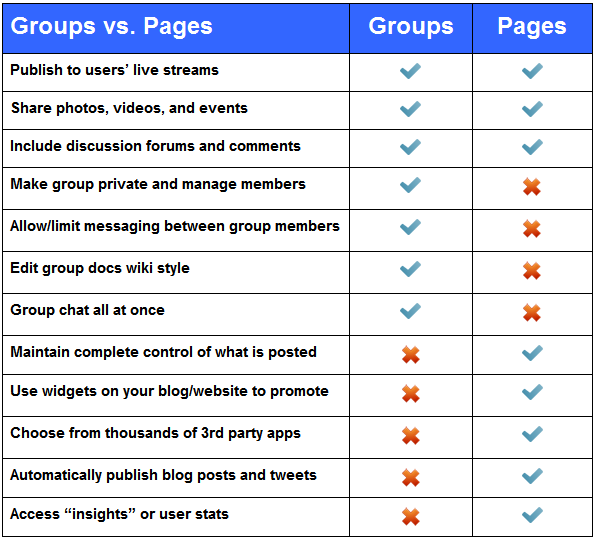As we entered the new decade, we expect Facebook to turn 16 this year. This means that there are hundreds of thousands of adolescents (around 18 years old) that never actually had the chance to perceive the world as a place, where The Social Network didn’t exist. Of course, Google and Apple are in a similar position, but their service is quite different.
If anything, the latter affects the way we are searching for information, and the devices we are using to do so. Whereas, Facebook is affecting the way we communicate, what we actually know about the world, and how our peers are perceiving us (based on our social media profiles).
As of today, there are more than 2.41 billion people on Facebook (2 410 000 000), and more than half of those people are participating in Facebook Groups.
What is the Difference Between a Facebook Group and a Facebook Page?
We believe that a business, a brand, or a person who is striving to reach and interact meaningfully with his or her audience, is obligated to have both i.e. a Group and a Page.
This is important as those Facebook functions allow people to gather around an interest or a brand but the interaction is different.
Facebook pages are still important, as having one, will make it easier for your audience to show their interest, what is more, they’ll have the option to seamlessly share the content that you published on the page, to “like” and “follow” it.
On top of that, lately, Facebook allowed for a Page to have News Feed, where you can follow other pages with yours, and interact with them publicly. Of course, you ought to be useful, and your contribution – valuable and targeted for the effort to be worth it.
As we’ve mentioned before, Facebook is all about community.
In short, this algorithm change means that the reach of your posts on the Facebook Page of your website will be lower unless people actually engage with it. And the lower the number of engagements the lower the reach will be.
On the other hand, Facebook Groups more often than not are notifying people when an interesting post appears in a group they are part of. Yet, as the differences are a lot, and they are not the main focus of the article, here is a great table, published by The Edublogger that pretty much sums it all up.

Image: www.theedublogger.com
How to Use Facebook Groups to Grow Your Brand?
Mainly, there are two manners in which you can use Facebook groups in order to grow your brand. Of course, the first is to create one around what your brand stands for, and the other is to use groups that already exist.
There is a huge advantage in doing either of those and, of course, the best results will come if you choose to do both.
Your Own Facebook Group
Creating a group that will lead to good results is not as straightforward as it might look, and definitely not as easy as creating a page. The reason is not in the steps you ought to take when creating the group, but in the thinking process that stands behind the name and the content.
It is not wrong, nor hard to come up with the name of your brand and to create the group. But that will hardly give the results that you hope for. You need to think of something extraordinary that makes positive impressions with zero effort. Nonetheless, try optimizing this as much as possible that name. Think of what people will be searching for and how well you can meet those searches.
Managing a Facebook Group will give you the chance to effectively promote your brand without high budgets for ads, you can reach more potential customers, engage with your audience on a more personal level, get valuable feedback and of course, important insights.

But how to fully use your group to grow your business? Focus on a few things.
- Start old-school – invite your friends and ask them to give you help by doing the same with their friends.
- Promote your group – if you already have a Page, then share your new Group there.
- Cross-promote it – Post about it in similar other groups and share it on social media platforms.
- Link it – Don’t forget it never hurts to share a link on your website, your profiles, or in e-mails.
After you boost your start, the following will be easier. You can contact influencers, engage people to share, and a lot more. Once you’ve reached a good amount of users and an active audience that’s interested in your group activity, you’ll find your business gaining from it. As long as you share attractive content daily, interact with the members of your group, and inspire them to trust you, like you, and buy from you, your business will grow.
Groups That Already Exist
The other way we’ve pointed out suggests high activity in groups that are managed by others but are close to your niche and the members are potential customers. This could be the lazier way to get close to your target audience, but it is also highly effective. You won’t have to take care of creating a group, promoting it, and most importantly, managing it – its posts, members, requests, etc. But you will have to spend a lot of time looking for groups that best fit your profile. This way the content you share there will meet the right people and is likely to motivate them to share, comment, like, give you insights, and affect your business’s growth.
Don’t forget that to do that, you need to focus a lot on your posts. How do you want to be represented? What kind of content will it be – photos, memes, links to your blog, links for purchases, simple text, infographics, or else? Answer those questions by keeping in mind what your audience segmentation is and what they’d like to see and read
